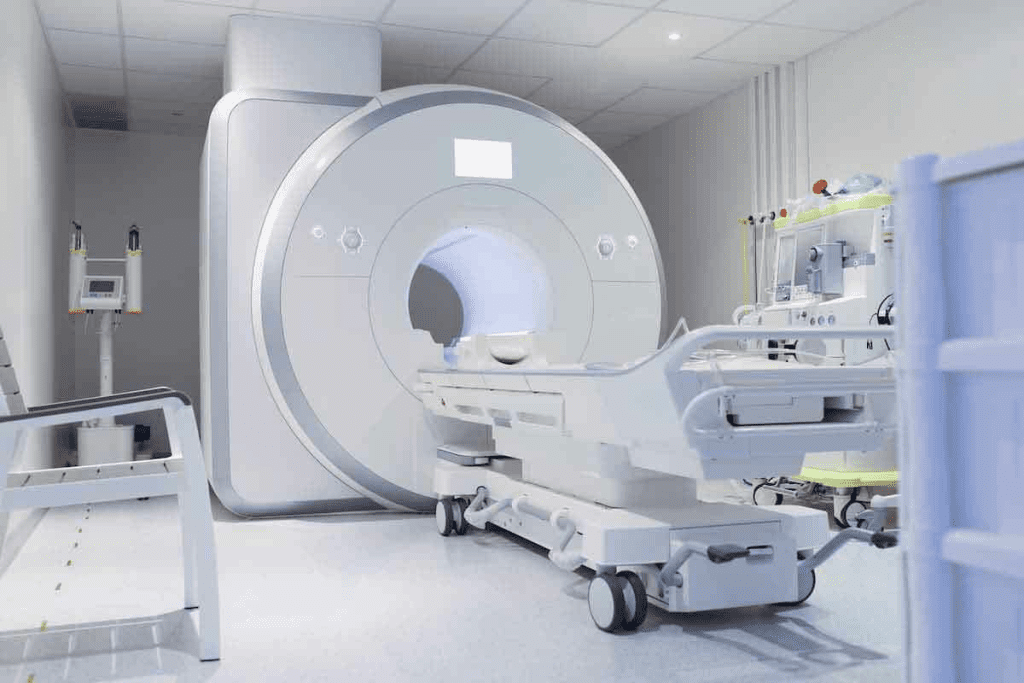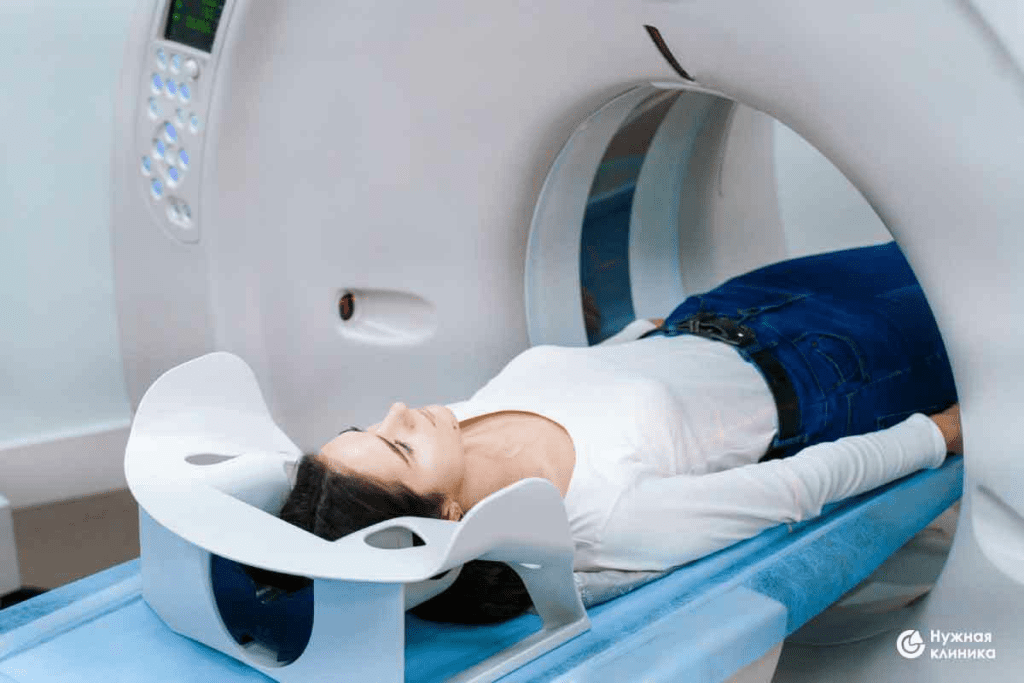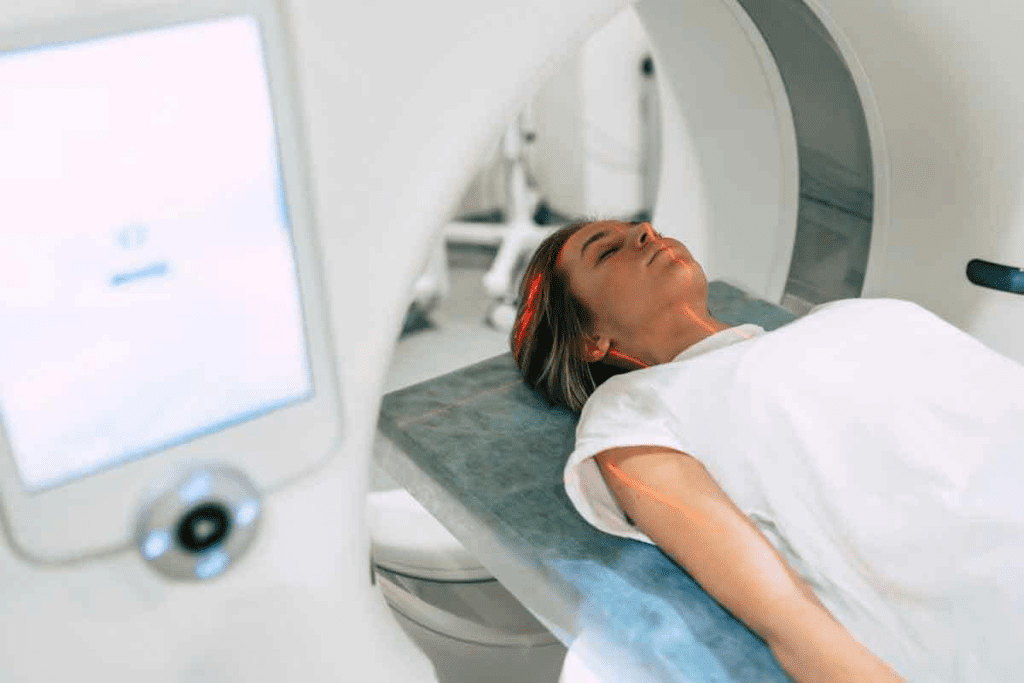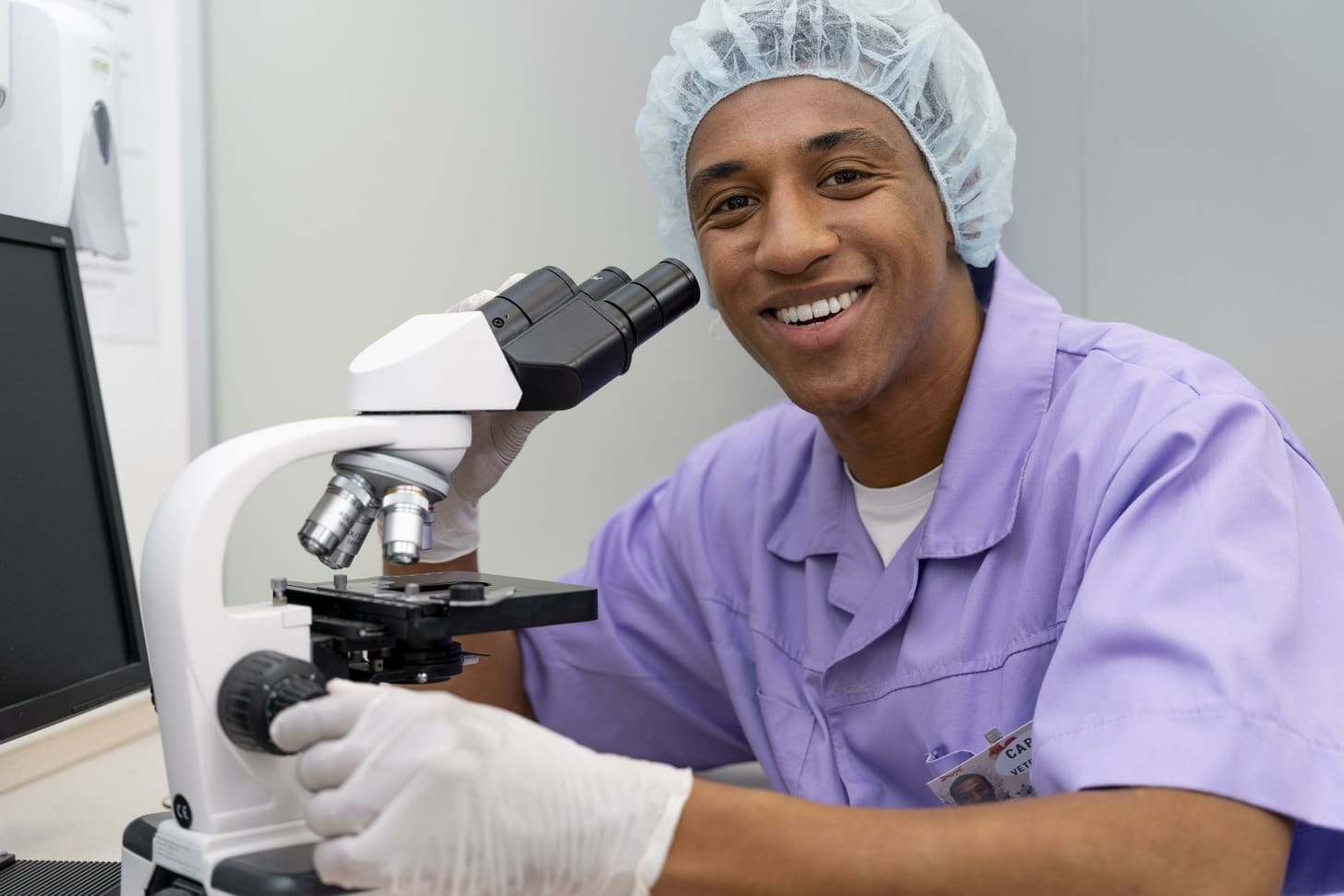Last Updated on November 27, 2025 by Bilal Hasdemir

Two advanced technologies are used in diagnostic imaging: MRI and CT scans. They are both important for finding medical conditions ” but is MRI scan and CT scan the same? The answer is no; they work in different ways.
CT scans use X-rays to show detailed images of the body. They are great for seeing bones, finding tumors, and spotting internal bleeding. MRI scans, on the other hand, use strong magnetic fields and radio waves. They are best for viewing soft tissues like the brain, spinal cord, muscles, and ligaments.
It’s important for patients to understand these differences. Knowing whether an MRI or CT scan is right for you can help make better health choices. In this article, we explore how these imaging methods differ and when each one is most useful..
Key Takeaways
- CT scans use X-rays, while MRIs use strong magnetic fields and radio waves.
- CT scans are faster and less expensive, making them ideal for emergencies.
- MRIs provide detailed images of soft tissues, making them suitable for diagnosing conditions affecting the brain, spinal cord, and other soft tissues.
- The choice between MRI and CT scan depends on the specific medical condition being diagnosed.
- Understanding the differences between MRI and CT scans can help patients make informed decisions about their healthcare.
Understanding Medical Imaging Technologies

Advanced imaging technologies are key in modern medicine. They let doctors see inside the body clearly. This has changed how we diagnose and treat diseases, without surgery.
The Role of Advanced Imaging in Modern Medicine
Medical imaging is now vital in healthcare. CT scans and MRI machines let doctors look inside the body without surgery. This helps them find problems, track diseases, and plan treatments better.
“Imaging technologies have transformed the field of medicine, enabling us to diagnose conditions earlier and more accurately than ever before.” “ A radiologist
These technologies have greatly improved patient care. They give doctors detailed views of the body’s inside. This helps them make accurate diagnoses and create specific treatment plans. For example, CT scans are great for emergency situations, helping doctors quickly see injuries or bleeding inside.
When Your Doctor Orders an Imaging Test
When your doctor orders an imaging test, it’s important to know why. The choice between CT and MRI depends on the condition, your medical history, and what information is needed for treatment.
Your doctor might order an imaging test for many reasons. This includes:
- Diagnosing the cause of symptoms
- Monitoring a known condition
- Guiding treatment decisions
- Finding health issues before symptoms show
Knowing the difference between CT scans and MRI helps you understand your doctor’s advice. As medical imaging gets better, these technologies will be even more important in healthcare’s future.
Are MRI Scans and CT Scans the Same? Fundamental Differences

MRI and CT scans are two different tools for looking inside the body. They work in different ways and are used for different things. This means they are not the same, even though they both help doctors see inside us.
Basic Technology Comparison
The main difference is in how they work. CT scans use X-rays to make detailed pictures of the body. They are great for seeing bones, lungs, and finding injuries right away.
MRI scans use strong magnetic fields and radio waves. They are better at showing soft tissues. This makes them perfect for checking the brain and muscles.
How Each Technology Creates Images
CT scans use an X-ray machine that moves around the body. It takes pictures from many angles. Then, these pictures are put together to show detailed cross-sections or 3D images.
MRI scans work differently. They use a strong magnetic field to line up hydrogen atoms in the body. Then, radio waves disturb these atoms. The signals they send back are used to make detailed images.
It’s important for patients to know why doctors might pick one over the other. It depends on what the doctor needs to see. Whether it’s bones or soft tissues, the right choice helps doctors take better care of you.
How CT Scans Work: X-Ray Technology Explained
CT scans use advanced X-ray tech to see inside the body. This method is key in modern medicine, vital in emergencies for quick, accurate diagnoses.
The Science Behind Computed Tomography
CT scans use X-rays to make detailed images of the body. You lie on a table that moves through a CT machine. It takes X-ray images from different angles.
These images are then put together into detailed pictures of what’s inside. An expert says,
“CT scans have revolutionized the field of diagnostic imaging, providing unparalleled clarity and detail.”
The CT scanner moves around you, capturing many X-ray measurements. A computer then makes images of your body’s inside parts. This tech shows bones, soft tissues, and blood vessels in ways we couldn’t before.
What Happens During a CT Procedure
During a CT scan, you lie on a table that slides into the CT scanner. The scan is quick, lasting just a few minutes. You might need to hold your breath for short times to get clear images.
The procedure is usually painless. But some people might feel uncomfortable because they have to stay very quiet or because of the contrast agent used in some scans.
Preparation is key to a successful CT scan. You might need to not eat or drink before the scan. Sometimes, a contrast agent is given to make images better. Our medical team will give you all the details you need to prepare.
Types of CT Scans Available
There are many types of CT scans, each for different needs:
- Standard CT scan: Used for general checks.
- High-resolution CT scan: Shows small details, like in the lungs.
- Spiral CT scan: Takes images as you move through the scanner.
- CT angiography: Looks at blood vessels and finds vascular problems.
Knowing about the different CT scans helps you understand your options. It also helps your healthcare team make accurate diagnoses.
How MRI Works: Magnetic Field and Radio Wave Technology
Magnetic Resonance Imaging, or MRI, is a cutting-edge medical imaging method. It uses strong magnetic fields and radio waves to show the body’s inside parts. This tool is key in modern medicine, giving a safe choice instead of other imaging methods.
The Principles of Magnetic Resonance
The science of MRI is based on nuclear magnetic resonance. When someone has an MRI, they sit in a strong magnetic field. This field lines up the body’s hydrogen atoms’ protons.
Then, radio waves knock these protons off track. As they get back to their original position, they send out signals. The MRI machine catches these signals and makes detailed images.
The key parts of an MRI machine are:
- A strong magnet for the main magnetic field
- Radiofrequency coils for sending and receiving radio waves
- Gradient coils to encode the signals
- A computer to make the images
The MRI Procedure
During an MRI, the patient lies on a table that moves into the scanner. It’s important for the patient to stay very quiet and not move. The scan’s length depends on what’s being looked at and the type of scan.
Some people might feel a bit uncomfortable because of the tight space or the loud machine sounds. But, today’s MRI machines are made to be more comfortable. They might even play music or use virtual reality to make the experience better.
MRI is great for getting clear images of soft tissues. It’s very helpful for checking the brain, spine, and joints. Knowing how MRI works and what to expect can help patients feel more ready for this important test.
Image Quality and Visualization Capabilities
MRI and CT scans have different image qualities and visualization capabilities. This makes each better for certain tasks. Knowing this helps doctors choose the right test for each patient.
What CT Scans Excel at Showing
CT scans are great at showing bones, lungs, and acute injuries. They give clear pictures of dense things like bones. Doctors often use them in emergencies to spot internal injuries or bleeding fast.
Key applications of CT scans include:
- Detecting fractures and bone lesions
- Imaging the lungs for conditions such as pneumonia or tumors
- Identifying internal injuries or bleeding in emergencies
What MRI Scans Excel at Showing
MRI scans are better at showing soft tissues. They’re perfect for looking at the brain, spinal cord, and joints. This makes them great for neurological and musculoskeletal checks.
As noted by medical professionals, MRI’s ability to visualize soft tissue is unparalleled. “MRI is the best choice for soft tissue issues, like some musculoskeletal and neurological problems,” says a top radiologist.
Key applications of MRI scans include:
- Diagnosing conditions affecting the brain and spinal cord
- Examining musculoskeletal disorders, such as tendon and ligament injuries
- Evaluating joint diseases, such as osteoarthritis
Contrast Agents: Enhancing Image Quality
Both CT and MRI scans use contrast agents to improve image quality. These agents make certain areas stand out, helping doctors make more accurate diagnoses.
“The use of contrast agents in medical imaging has revolutionized the field, allowing for more precise diagnoses and treatment plans,” according to a recent medical journal article.
Understanding MRI and CT scans’ strengths and weaknesses helps doctors choose the best test for patients. This leads to better care and outcomes for patients.
Time, Noise, and Comfort: The Patient Experience
Knowing the differences between CT scans and MRI scans can ease anxiety and improve results. Patients want to know about the time, noise, and comfort they’ll experience during these tests.
CT Scans: Quick and Relatively Comfortable
CT scans are fast, lasting about 5-10 minutes. This quickness is a big plus for anxious or claustrophobic patients. “The quick nature of CT scans makes them a more comfortable option for many patients,” say medical experts.
The process is simple. Patients lie on a table that slides into the CT scanner. The machine then takes images of the body area in question.
One major advantage of CT scans is their speed. Patients can often finish the scan in just a few minutes. This is great for those in pain or who can’t stay in one place for long.
MRI Scans: Longer Duration and Confined Space
MRI scans, though, take much longer, often 20-90 minutes. This can be tough for patients, and those with claustrophobia find it hard. The MRI machine is a big, enclosed tube that can make some feel anxious or uncomfortable.
The confined space of the MRI machine is a common worry for patients. But, many MRI facilities now offer open MRI machines or other comfort measures. These efforts help, but MRI scans are often harder for patients than CT scans.
In summary, CT scans and MRI scans are both important for diagnosis but offer different experiences for patients. Understanding these differences helps healthcare providers prepare patients better and improve their experience.
Radiation Exposure and Safety Considerations
When choosing between MRI and CT scans, it’s important to think about radiation exposure. Understanding the safety of each technology helps us make better choices.
CT Scans and Ionizing Radiation
CT scans use X-rays, which are a form of ionizing radiation. This radiation can harm living cells. It’s a concern for:
- Children, because their bodies are growing and they have more years ahead.
- Pregnant women, as their unborn babies are very sensitive to radiation.
- People who need to have many scans, as the total radiation can be harmful.
Even though there’s a risk, CT scans are often needed to get important health information.
MRI: Radiation-Free Alternative
MRI scans don’t use ionizing radiation, making them safer. MRI uses strong magnets and radio waves to create images. This makes MRI a good choice for:
- Patients who need many scans.
- Pregnant women, when it’s safe and needed.
- Children, to avoid radiation.
But MRI isn’t for everyone, like those with metal implants or pacemakers. It’s a great option without radiation.
Weighing Radiation Risks Against Benefits
Choosing between MRI and CT scans means looking at the benefits and risks. CT scans are often key for diagnosing many conditions. But for some, MRI is better because it doesn’t use radiation.
Healthcare experts should help decide which scan is best. They consider what each patient needs.
Cost and Accessibility Differences
MRI and CT scans are not just different in technology. They also vary in cost and availability. This affects how easily patients can get these tests. Patients and healthcare providers need to understand these differences.
Factors Contributing to Cost Differences
MRI scans are usually more expensive than CT scans. This is because MRI machines are pricier to buy and keep up. Also, MRI scans often need more skilled people to do them.
Key factors contributing to the higher cost of MRI scans include:
- The high cost of MRI machinery and maintenance
- The need for specialized technicians to operate MRI equipment
- The longer duration of MRI procedures can impact facility throughput
Availability and Wait Times
CT scans are often easier to find than MRI scans. This is true, even in urgent situations where quick diagnosis is key. The availability of MRI and CT scans can change a lot depending on the place and the healthcare facility.
| Imaging Modality | Typical Cost Range | Average Wait Time |
| CT Scan | $500 – $1,500 | 1-3 days |
| MRI | $1,000 – $3,000 | 3-7 days |
Note that costs and wait times are approximate and can vary based on location, insurance, and specific healthcare provider.
Insurance Coverage Considerations
Insurance plays a big role in how much patients pay for MRI and CT scans. Most plans cover these tests when they’re needed. But, how much they cover can differ a lot.
Patients should:
- Verify insurance coverage before undergoing an imaging procedure
- Understand any out-of-pocket costs associated with their imaging test
- Discuss alternative imaging options with their healthcare provider if cost is a concern
Clinical Applications: When Doctors Choose CT vs. MRI
Doctors often have to decide between CT scans and MRI scans for their patients. Each has its own strengths and uses. The choice depends on the patient’s condition, health, and what information is needed for a diagnosis.
Conditions Best Diagnosed with CT Scans
CT scans are great for quick and accurate imaging. They’re perfect for emergencies. They’re best for seeing bones, lungs, and solid organs. This makes them great for finding fractures, lung diseases, and injuries to internal organs.
Conditions Best Diagnosed with MRI
MRI scans are better for soft tissue conditions. They’re great for the brain, spinal cord, and joints. They’re essential for diagnosing complex conditions like multiple sclerosis and herniated discs.
Emergency Situations: Why CT is Often Preferred
In emergencies, CT scans are often the first choice. They’re fast, available, and provide quick, critical information. They can spot life-threatening issues like internal bleeding and stroke. They’re perfect for emergency departments because time is of the essence.
Knowing when to use CT and MRI scans helps doctors make better choices. This leads to better care for their patients.
Conclusion: Making Informed Decisions About Your Imaging Tests
Knowing the difference between MRI and CT scans is key to good healthcare choices. This guide helps patients understand their options better. It lets them work closely with doctors to pick the best tests for their needs.
When deciding between MRI and CT scans, talk to your doctor about your situation. This way, you can make choices that fit your health needs. You’ll get the right diagnosis and treatment plan.
Being well-informed about MRI and CT scans helps patients take charge of their health. Choosing the right test leads to accurate diagnoses and effective treatments. This results in better health outcomes for everyone.
FAQ
What is the difference between an MRI and a CT scan?
MRI and CT scans are both used to see inside the body. But they work in different ways. MRI uses a strong magnetic field and radio waves. CT scans use X-rays.
What does an MRI show that a CT scan doesn’t?
MRI is great for seeing soft tissues like organs and tendons. It’s best for checking the brain, spine, and joints. CT scans are better for bones and quick injuries.
Are MRI and CT scans interchangeable?
No, they’re not the same. The right choice depends on what you need to see.
Does a CT scan use magnets?
No, CT scans use X-rays, not magnets.
Is a CT scan magnetic?
No, CT scans don’t use magnets. They use X-rays instead.
What can an MRI show that a CT scan cannot?
MRI shows soft tissues like organs and tendons. It’s good for finding conditions like multiple sclerosis and some cancers. It’s also great for ligament and tendon injuries.
Are a CT scan and an MRI the same?
No, they’re not the same. They use different tech and are for different needs.
What is the difference between a CT scan and an MRI in terms of radiation exposure?
CT scans use X-rays, which are radiation. MRI doesn’t use radiation. This makes MRI safer for people who need many scans or are sensitive to radiation.
Why are MRI scans typically more expensive than CT scans?
MRI scans cost more because of the advanced technology. They have a strong magnetic field and radio waves. The detailed images they provide are often critical for diagnosis.
Are there differences in the patient experience between MRI and CT scans?
Yes, there are differences. MRI scans take longer, and you’re in a small space. CT scans are quicker and more comfortable, but they use X-rays.
How do insurance coverage considerations differ between MRI and CT scans?
Insurance for MRI and CT scans varies by provider and policy. Both are usually covered when needed, but costs can differ.
When are CT scans preferred over MRI scans?
CT scans are faster and better for emergencies. They’re good for quick injuries and conditions like bleeding. They’re also used for some procedures and checking organs.
Can both MRI and CT scans use contrast agents?
Yes, both can use contrast agents to improve images. CT scans use iodine-based contrast, while MRI uses gadolinium-based contrast.
References
- Baiguissova, D., et al. (2023). An economic impact of incorrect referrals for MRI and CT scans: A retrospective analysis. Journal of Medical Imaging and Radiation Sciences, 54(2), 123-130. https://www.ncbi.nlm.nih.gov/pmc/articles/PMC10009910/
- Florkow, M. C., et al. (2022). Magnetic resonance imaging versus computed tomography in orthopedic diagnostic and treatment planning: A systematic review. European Journal of Orthopaedic Surgery & Traumatology, 32(1), 45-55. https://www.ncbi.nlm.nih.gov/pmc/articles/PMC9305220/
- Javed, A., et al. (2025). Comparative analysis of MRI and CT scan for the diagnosis of brain tumors, considering MRI as gold standard. Journal of Health and Wellness Care Research, 3(1), 15-27. https://doi.org/10.61919/a82eqd69






